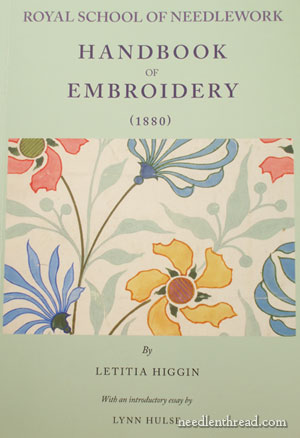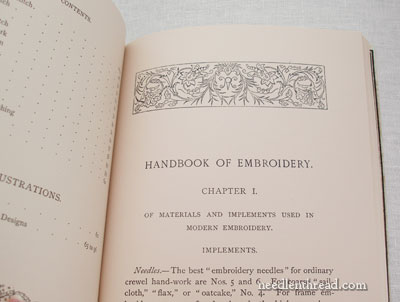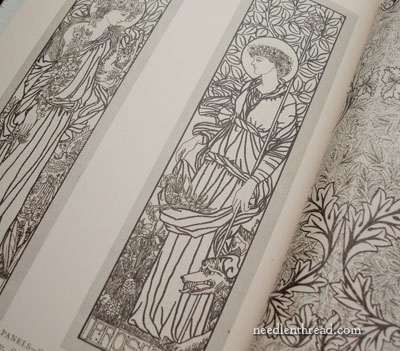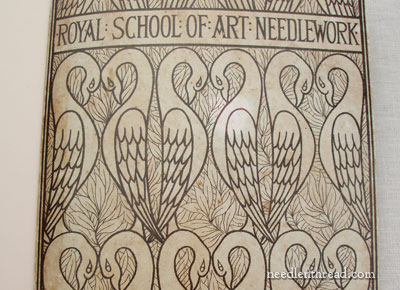This book review has been a Long Time Coming! I’ve had the book for a while – sent to me by a friend – and while my plan was ever to review it for you all, I felt I couldn’t do a review justice by a cursory reading of the book. Finally, I have read it from cover to cover, and I feel (somewhat) confident in writing a review.

It’s a lot easier to write a review of a technique book. The RSN Handbook of Embroidery might sound like a technique book (and there is certainly technique in it), but the compelling part of the book is not the technique.

The RSN Handbook of Embroidery (with an introductory essay by Lynn Hulse) is a piece of history, and it tells the story of a unique part of great institution’s history. The book is divided in two – the second half (the fawn color pages in the photo above) is the actual Handbook of Embroidery – a facsimile edition of the 1880 publication of the Royal School of Embroidery’s handbook. The first half of the book (the lighter colored pages in the photo) is the introductory essay by Dr. Lynn Hulse.
But it’s not just any “essay.” It’s a thoroughly researched history of the handbook and the school’s attempt to, in a sense, “codify” needlework at a time in history when this hadn’t really been done widely before.
Today, we tend to take for granted all the instructional books that we have at our fingertips. If we don’t have them on our own shelves, we can pop down to the public library and borrow them for free, or we can hop on line and find many, many instructional works for embroidery available for nothing. But imagine a time in history when women were doing needlework from home – often as a means of support – and instructional materials were not really to be widely had (or very few were, anyway). The RSN set out to solve this dearth, and to make its mark in the marketing of embroidery instructional materials, by producing a handbook.
When you read this book, you will come to appreciate the influence that the handbook had on needlework. And for anyone who is interested in the history of needlework, I think this book must be read. Why? Because it gives in detail a behind-the-scenes view of one of the most important endeavors of the RSN, and in doing so, it exposes much of the needlework movement that preceded our era and guaranteed the survival of the needle arts.
So what’s in the book? We’ll go from the back, forwards.

The back half of the book begins with the handbook itself.

Inside the handbook, you’ll find the techniques practiced by the RSN in the 1880’s spelled out. There is good technique information in here, and for the historical needleworker, you won’t want to miss it. But keep in mind, this is not the same type of technique book that we see today. Pictures and diagrams are fewer, and text is more abundant.

But that’s not to say that useful diagrams are not there – you’ll find good diagrams of different techniques.

You’ll find magnificent pattern pages, some in color, some presented as line drawings…

… like Selwyn Image’s panels of the four goddesses. (This is a shot of Propserpina, which I adapted into my own version of the same panel – a project I hope to return to this year.)
So that’s the back half of the book.

The first half of the book, being scholarly research, is mostly text. You’ll find here a completely thorough, scholarly exposure of the history of the handbook, which further sheds light on the history of the Royal School of Needlework and the needlework movement during that time period.

At the end of Dr. Hulse’s research, though, you’ll find pictures – magnificent photos of works of the Royal School (many designed by prominent artists of the age). If you’re a picture-person, this section of the book is definitely for you! There are some fabulous works of art here, along with photos from the history of the school scattered throughout.

One of my favorite images in the book is the inside back cover, which displays a facsimile of one of the covers used on the handbook. I’m not sure why I like it so much – I think it’s striking.
So that’s the “new” RSN Handbook of Embroidery – a work of the past, brought to life through the deep and careful research of Lynn Hulse.

Incidentally, Dr. Hulse is presently preparing further research on items produced by the Royal School in its earlier years. She sent me a photo of the “signature” label that was usually affixed to embroideries prepared by the Royal School of Art Needlework (its former name) from 1875 onwards. Sometimes, the embroideries would have this whole label on it, or sometimes, just the monogram on the left side of the label. If you or anyone you know happens to be in possession of such a work with such a mark on it, will you let me know? It’s difficult to track these things down, but if enough people got the word out, who knows? We might be able to come up with something.
Well, if you love embroidery and you appreciate the fact that what we have today has been built upon what came before us, read this book!







Looks like another one for the wishlist (which is largely populated by things you’ve reviewed!)
Because of my love of all things needlework, I will definitely be putting my name in the hat for this book! -Its not that I don’t have many books already, but for the history…if it weren’t for those that handed down their love and sometimes necessity of needlework, where would we be?!?!?!
Thank you for another incredibly helpful review. I agree with Anne — you are responsible for many items on my wishlist. This one really caught my attention, and I didn’t want to risk not winning your (always popular) giveaway, so ordered a copy today! Can’t wait to receive it. The other items on my wishlist will just have to wait a bit longer.
Thank you so much for this rewiev.
This book is now on my wishlist – I can’t wait to study all the old instructions and the patterns that I find so hard to find.
Mary,
I’ve added another book in my wishlist…..even though I can’t afford one right now.
Thank you so much.
Anita-MM
At the risk of sounding like ‘me too’, I have to agree with the sentiments expressed by the others. One of my favourite books of late was one recommended by you – Gail Marsh’s book about early 20th century embroidery. I imagine that this one will have some parallels with it, yet be completely different, in that GM concentrated mostly on Glasgow. This one is on my wishlist and the only reason I don’t just do it now is the cost of postage – I wait until someone has it a tad cheaper.
Have you had time to do anything with the Proserpina piece? (I followed your link back to Nov 2010.) Ditto the other beautiful drawing you show in that post? Are there pictures anywhere? Janet.
Hi, Janet – those were projects I was lining up to teach in a couple classes, but the classes fell through because of my time schedule, so I put them on the back burner. I do want to address them this year at some point, but I suspect I’ll be pretty busy with other projects through the end of the summer. So, I’m hoping that, in the fall, I can revisit these! That’s my plan, anyway. We’ll see if it pans out! ~MC
Annnd my wish list just got longer too!
Are there really so many more *good* needlework books being produced in the last few years, or is it because I found your blog and reviews that it just seems that way? When I say good needlework books, I mean both in quality of content and type of needlework shown, and not usually found in the chain book stores.
I think there are more good books being produced, because there’s more of a market for them, since this type needlework is becoming more and more popular and folks are becoming more interested in the history of fine needlework. But that’s just the way I see it! 🙂
What’s NOT to be treasured about something (ANYTHING) from RSN! I’ve been in London several times, and ONCE, we walked to the RSN. I could look in the windows and was in AWE. My husband said, “Let’s go in.” Oh, I was NOT stepping inside because RSN’s level of embroidery was SO FAR above my own. I was just humbled to be in presence of the building, let alone anything they DO there! I laugh now, and I have a dream of taking some of the courses I read about. WHEN I retire, that’s just about the highest action item on my to-do list!
Wow! What a wonderful book. I like the history of embroidery and the school. How cool is that. Wish they had that when I was in school, I would have done much better. My son would also enjoy this book also. Thanks, Kathy
Sounds like a great book. I would love to read all about the history of embroidery. Seems to be a lost art—at least where I live. I am interested in the stitch instructions as well. And I think the pictures would make great templates. I can visualize using the goddess pictures to do a russian crochet panel.
This book links the women of today who stitch with the women throughout history who stitched–there is a sense of generations and continuation and owning this book fills that need to know more about the who why and when of embroidery–it gives honour to those who came before us. Sitting with my V and A fashion books it would be comfortable amongst other inspirational printed matter.
What a beautiful book and an amazing opportunity to own it.
What a great book. The pictures, the history, the techniques. Alot of information on needlework.
I have always been a fan of William Morris and the designs of that time. I so wish I could afford to go to the Royal School of Needlework. I looked through there courses and did a bit of daydreaming. The book is incredible though and would be a valued addition to anyones library.
This wonderful history would be a perfect gift to my local library… after I read my fill of it.
fascinated by the history in the book – and the beautiful illustrations! if I win, will share this with my daughter… elmac
Mary,
Thanks for telling us about this beautiful book. I love history and needlework and this is a combination of both. I love the line drawings in the 1880 book and also the lovely color photography in the newer version. This is a “must have” book.
Ruth on the First Coast
Everything about this book is so interesting. I have never explored the history of stitching and never thought I would have a chance to see the RNI even in book form. Thanks for the opportunity to win the book.
I am captivated by the history and then the artwork. True artisan study. Thanks for the exposure to this.
My dream is to be able to attend classes at RSN but since that seems unlikely, I am intrigued by anything connected to the school.
Beautiful book. Always enjoy your picks!
Connecting with the history of neeedlework connects me to those women of long ago. This history is fascinating to me. Please include me in the drawing for this valuable book.
Mary,
I am surrounded by embroidered pieces that have stories to tell. Each one has its own history and I can only imagine in my mind’s eye who the person could have been who created the work in front of me. (I am also surrounded by furniture in my house that does the same thing! None refinished, all speaking about the past, loud and clear!) I lived in London for a year when I was a young woman. I had just started to stitch and had no idea that the Royal School of Embroidery existed. Having this book would help me to understand the past and apply it to my future needlework endeavors. The brass rubbings I made, over 50 of them, often have stoles and other liturgical garb of the 15th century and on. I am sure I would be able to learn more about these treasures from this valuable book.
I will continue to dream of visiting the Royal School of Embroidery some day.
Love this book and find it valuable. I love the history of needlework and constantly reading and learning. When I started stitching books were limited so now I am always learning new techniques and perfecting my stitch. I love the Royal School and if every possible I would take a class at the drop of a hat. Time and money keep me close to home. Needlework is my outlet as I am a caregiver. Keeps me sane.
The chances of me seeing thier commissions first hand, live and in person, run from slim to none. This book would be the next best thing in understanding the development of their work. I am in awe of the talent of these true fiber artists
What a lovely thought, until you had mentioned this group I hadn’t heard of them. I can imagine living in that time and loving being able to make $ and gather in a place to work on handwork. It must have been wonderful. I sometimes think I should have been alive when this type of group effort was commonplace. i.e. quilting bees and such.
Thank you for this opportunity and congrats to whomever wins it!
So glad I found your most helpful website!Many thanks for the technique videos and pictures.
Mary,I have often wondered what patterns my grandma used for the pieces she left to me.She was born,1888,Michigan.We never found a single written guide for some of the most amazing pieces displayed in my cabinet.Please include me on the list of wishers for the beautiful guide book you are generously offering.Judy Cadle,Michigan.
It amazing to me that there is not enough people, family members, anybody that I know, BUT me, that enjoys doing embroidery by hand. To have a book that shows the history and how it was done and past down thru the years is amazing in itself. As well to be able to own a piece of the past. Would love to own this book forsure…..
We could win a book from the RSN? Woo-Hoo! I especially am interested in the history contained inside; but the pictures/photos definitely grab my attention! Love anything related to the Royal School of Needlework!
I love all of the above Everything is beautiful & I love the history that is included!! It would be a real delight to have in my library!
Technique, gorgeous photos and history all in one book? Who could ask for more? I think technique will be the most useful, and the rest is a bonus. Count me in!
I am fairly new to techniques of embroidery and have been helped by a lovely lady who is a master at the craft. This book would make the perfect gift for her. Judy researches everything before she stitches and her pieces are magnificent, this book would thrill her. Fingers crossed xx
I love the English language of that time period and through the turn of the century. I have some other old stitch books and they are so interesting. May not be as easy to learn as the books of today, but that is where our ancesters learned, and they did some beautiful needle work. Thanks Mary
I love to read about the history of needlework and to learn some of the old stitching techniques. I collect many needlework books and it’s so much fun to read needlework books to get inspiration for new projects!
I am a history buff AND a book lover. I love the feel of a book in my hands. I am dying to see past RSN projects. I saw one completed entirely in couching of a Bristol Bomber & anticipate enjoying & being inspired by the history of RNS & different techniques. HOPE I WIN!!!!
As a lover of books and an ardent fan of needlework I would dearly love just to hold this wonderful book in my hands. As with fabric I find myself stroking book covers a thing we do subconsciously I think. Thank you
for the opportunity I look forward to the day when I just may be able to visit The Embroiderers Guild at Hampton Court.
Thank You Meriel Huntington
I was introduced to the Royal School of Needlework many years ago when I frequented a shop run by Marion Scouler. A course there is definitely on my “bucket list”! The book would only serve to strengthen that desire, I’m sure.
I really love embroidery and got to learn a bit about the history through the embroidery studies courses I have completed. I have a new respect for these earlier needleworkers who created such magnificent pieces with such limited availability of supplies, in comparison to what we have today. I definitely think this book will be added to my wish list. Thank you for sharing it.
I collect many “how to” books. This would be the ultimate book for anyone to have. It wouldn’t be in the same category. I have learned so much from your website.Winning this book, the history, the embroidery knowledge,it would be an honor to win this book. I would share it with my son who is a history buff also. He loves to examine my work.
He is now an OTR trucker, so I don’t get to see him as much now
I think the History of this book and technique is the most intresting thing to me. I love to read the history of all embroideries. I was very inpressed to find out that Sytumpwork started in the 17 th century. Although The RSN has its own history the histoy of techniques are interesting to me.
There are so many things that draw me to the RSN Handbook of Embroidery. The history of the needlework that has been passed down through generations of women (men too) amazes me. I love the way you have reviewed the book, it helps to have a good visual of what we are reading about. Th history, line drawings, examples….they all make me drool! I would be honored to have a book of this quality in my collection.
Thanks Mary! I don’t know what I would do without my daily “fix” of needle n thread!
I’m so excited at the chance to win this book…ever since your review I’ve been watching it on several websites (waiting for some miracle price to appear). I’m so drawn to the historical aspects and would love to be reminded of my two years living in London (Margaret was PM!)when every window I looked out of reflected centuries. Thanks, Kate
Love your daily emails Mary, I am so happy I came upon your website!! as for the book it looks wonderful!! I love learning new techniques and the history of embroidery and would love to add this book to my personal library – thanks for all of your valuable information on the wonderful world of embroidery:)
This book looks wonderful! Your really tease us with those pictures! I have always admired the precise detail of the RSN from pictures I have seen online, and I long to perfect my stitching to that degree. I hope that this book would help me be a better embroidress. (Is that the right word?) This book is going on my wishlist for next Christmas.
I think this book would make a good read
along with the pretty old designs it has.
I would love to win it.
Robin
Hello Mary
Another great give away.
I think the history in this book would be interesting to read, also the photos of the work that would have been done over the years would be good to see whether it is technique or finished work.
A wonderful book to own.
Regards Lynn.
Hi Mary
Thanks for the wonderful book review. Wish I had ordered that one also. Its so light and airy looking. What a wonderful bit of sewing and history.
Hi,
it is a book that I would like to have. If I do not win, I have to buy it for me and for the Library Guild. I was the librarian of my local Guild. I like this book for History and technique.
Thank you very much,
Nicole Gelinas from Laval Quebec
HI Mary,
The genuine book is fabulous, thanks for recommending it. This is just to let you know that there is a book out there which claims to be the Handbook, but could be a reprint of an early pirate copy which is missing vital information. Possibly it is now legal after the passage of time, I don’t know. It is currently on Amazon, with adverse customer comments, and at least one person has said she sent it back and complained to Amazon. I’m anxious to ensure that it is not confused with the genuine article which I bought on your recommendation and absolutely love. I think Lynn Hulse’s essay is a real gem, what a treat. One way to tell them apart is to look for Lynn Hulse’s name of course!
Op 13 februari gelezen over Handboek of embroidery. Door u aanbevolen! Gekocht Handboek of embroidery Illustrated Edition.
Zonde van mijn Euro’s!!. Zonder kleur en geen waarde. Teleurgesteld over uw aanbeveling.
Hi Riet,
Are you sure you bought the right Handbook? The one Mary reviewed does have colour and illustrations. The one you are disappointed with sounds like the one that is not the one published by the RSN and does not, as you say, have colour or illustrations.The RSN one does.
Hello, I just read your article and found it informative. I was given this book to go into a living estate sale for an amazing woman who is a master craftsman in canvas work. I have a copy of this book published in 1880 with your favorite image on the cover. It is in good condition with some wear to the spine. The really interesting fact is I have a letter which accompanied the book. The letter states that Federico Pardo and his wife Guadalupe Marron gave the book to the letter writer. Lupe was a great granddaughter of General Vallejo who was the last Mexican governor of California and the granddaughter of General Frisbee that was the first American governor of the State by the end of the XIX century. This book was inherited by Mrs. Padro and as they didn’t have any children, passed the collection to the letter writer. The letter writer then passed it on to my estate sale client. Is this an item you would be interested in purchasing? I will be trying to sell on-line, but do enjoy getting special items to people who really want them. Let me know if interested or know of someone who may be interested.